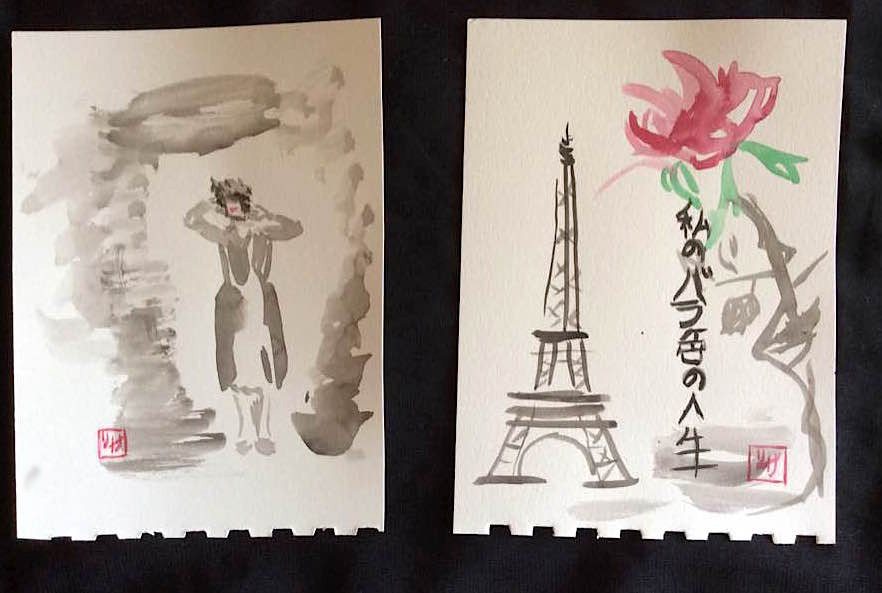
Sumi-e is as much a fine art style as folk art, but it is certainly a familiar, beautiful art style of East Asia.
Sumi-e, Japanese for “black ink painting,” is the traditional brush style painting that is seen in East Asian countries including China, Korea, Malaysia, and Japan. China introduced the method to Japan in the 15th century, but every country has developed its own style based on this traditional method.
Although its materials are simple (brush and ink on paper), the method is conducted in very specific ways. According to the description from Sumi-E Society of America, “emphasis is placed on the beauty of each individual stroke of the brush” in what Chinese artists describe as “painting a poem” or “writing a painting.”
“A great painting was judged on three elements: the calligraphy strokes, the words of the poetry […] and the ability of the painting strokes to capture the spirit (Ch’i) of nature rather than a photographic likeness,” society member Carla Jaranson wrote of the work.
Even the types of ink and brushes used had meaning. Traditional Sumi-e brushes are created using natural materials, such as bamboo and hair, and the paintings are done on either handmade paper (rice paper) or silk.
Sumi-e art can range from calligraphy to landscapes to portraits of animals and people. There are also many types of brush strokes learned (straight stroke, side stroke, etc). Artist and writer Kazu Shimura has a variety of how-to tutorials on YouTube teaching Sumi-e styles including this one on basic strokes and methods.
Most students start out primarily in black ink on white paper, and later learn to introduce color. They often learn what is known as the “Four Gentlemen,” first referring the four seasons: bamboo (summer), chrysanthemum (fall), plum flower (winter), and orchid (spring).
Even as students branch out into other images, the heart of Sumi-e is the simple black ink on paper.
“Black ink painting provokes your colorful memory,” Kazu writes in his introduction to the method, further saying, “More you think, more you find.”

The Project: It’s “Sumi-e” Rock-n-Roll
My apologies for purists of the Sumi-e tradition for both the bad pun in the project title, and for doing this project without the traditional tools.
There are some wonderful Japanese ink painting materials available in art supply stores, so if you want to get serious about this art, by all means, make that purchase. A set of brushes can be as inexpensive as a $5 off art sites like DickBlick.com, with Japanese rice paper around $10 to $15 for a pack.
For this project, however, we’re going with what we have readily available around the home: a set of regular old paint brushes, watercolor paints, and white construction paper.
Now, as Sumi-e has been described as “painting a poem,” we’re going to get a little more contemporary and paint a diptych (two painting sets) based on some modern day “poets”: rock stars.
The first painting is really cheating of a sort, as it is really tracing. The Sumi-e Society said some artists learn painting by “copying the Old Masters’ paintings, stroke by stroke.”

Instead of copying a painting, copy a photo. Find a good picture of a musician (an album cover image or publicity photo is fine), and place a thin piece of paper over it, then reproduce it using Sumi-e style brush strokes. Practice with some side strokes (using the side of the brush) and straight strokes (the tip of the brush), and trace along the edges of the image, as well as some (not all) of the details. This is good practice learning the feel of the brush strokes, different brush sizes, and the flow of the paint.
You don’t have to think up an original idea yet, just learn the strokes on an existing image.
The second painting, a companion piece to your portrait, is a free-form study. Listen to a favorite song by that artist and paint what comes to mind. These can be images based on the lyrics, tune, or era it represented. This can be abstract images, several symbolic images (notes, flowers, etc.), or one representative image. Try not to copy a music video of the song (if there is one). Use your own imagination.

This will be the companion piece for the portrait. If your artist is Kurt Cobain, try listening to “Come as You Are” or “Smells Like Teen Spirit.” Siouxsie Sioux’s “The Passenger,” Little Richard’s “Good Golly, Miss Molly,” and so on are also great places to start.
For both these images, complete the initial drawing in black paint, but try adding a few colored strokes as highlights (avoid using more than one additional color).
For one last touch, a Sumi-e style painting is often signed with little “stamp,” mainly in red, of the artist’s name. Make a little box with a thin brush, and fill in your initial or name in a Japanese or Chinese calligraphy style. This finishes the images off nicely.
I like to use a site called JapaneseTranslator to do this, and it also works well if I want to add text to the image itself.
Remember, the purpose of this is to create an image you like of an artist whose style you admire. Do this project with your kids, and compare their favorite artists with your own. It doesn’t matter how great the images are, just that you are being creative together.
As one Chinese Proverb says: “share an old pleasure with a new friend, and lift up the heart of a true friend by writing his name on the wings of a dragon.”



